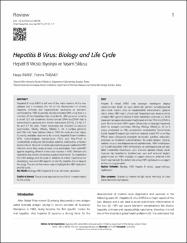Hepatitis B virus: Biology and life cycle
Künye
Inan N, Tabak F. Hepatitis B virus: Biology and life cycle. Viral Hepatitis Journal 2015; 21(1): 1-7. doi: 10.4274/vhd.36036Özet
Hepatitis B virus (HBV) is still one of the major reasons of the liver disease and it increases the risk of the development of chronic hepatitis, cirrhosis and hepatocellular carcinoma as late-term complications. HBV is partially double-stranded DNA virus that is a member of the Hepadnaviridae virus family. HBV genome contains a small (3.2 kb) covalently closed circular DNA (cccDNA) that is transcribed to generate four known transcripts (3.5 kb, 2.4 kb, 2.1 kb and 0.7 kb size). These transcripts are encoded to produce polymerase, HBcAg, HBeAg, HBsAg (L, M, S surface proteins) and HBx that have defined roles in HBV life cycle and liver injury. Currently, available treatments for chronic hepatitis B are interferon (IFN) monotherapies (conventional IFN-α and Peg-IFN-α) or nucleos(t)ide analogues (lamivudine, adefovir, telbivudine, entecavir and tenofovir). None of currently approved drugs are curative for HBV infection since they rarely achieve virus eradication. New anti-HBV agents targeting different molecules involved in HBV infection and replication are needed to achieve curative treatments. To understand the HBV biology and life-cycle in detail is of critical importance for developing new anti-HBV agents to identify possible future targets for drugs. The aim of this review was to highlight the HBV replication and life cycle. Hepatit B virüsü (HBV) hala karaciğer hastalığının başlıca nedenlerinden biridir ve uzun dönemde görülen komplikasyonlar olan kronik hepatit, siroz ve hepatosellüler karsinomanın gelişme riskini arttırır. HBV kısmi çift-sarmallı Hepadnaviridae ailesine ait bir virüstür. HBV genomu bilinen 4 farklı transkripti oluşturan 3.2 kb’lık süpersarmal yapısında kovalent bağlı kapalı sirküler DNA (cccDNA)’yı içerir. Bu transkriptler HBV yaşam siklusunda ve karaciğer hasarında belirli rol oynayan polimeraz, HBcAg, HBeAg, HBsAg (L, M ve S yüzey proteinleri) ve HBx proteinlerini sentezletirler. Günümüzde kronik hepatit B tedavisi için interferon tedavisi (klasik IFN –α ve Peg-IFN-α) veya nükleoz(t)id analogları (lamivudin, adefovir, telbivudin, entekavir ve tenofovir) kullanılmaktadır. Bu onaylı ilaçların hiçbirisi, nadiren virusun eradikasyonuna yol açtıklarından, HBV enfeksiyonu için küratif değildirler. HBV enfeksiyonu ve replikasyonunda yer alan farklı molekülleri hedefleyen yeni anti-viral ajanlara ihtiyaç vardır. Gelecek ilaç hedeflerinin belirlenmesi, yeni sınıf anti-viral ilaçların geliştirilmesi için HBV biyolojisi ve yaşam siklusunu anlamak kritik önem taşımaktadır. Bu derlemede amaç HBV replikasyonu ve yaşam siklusunu vurgulamaktır.


















